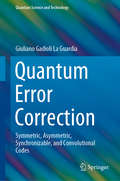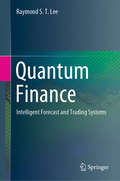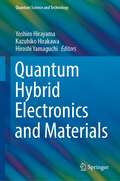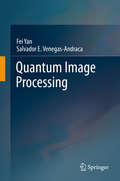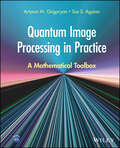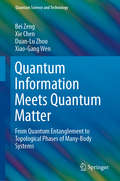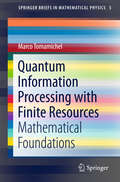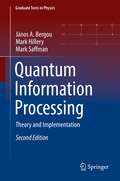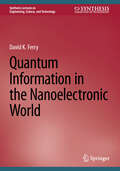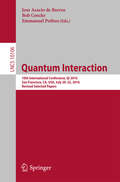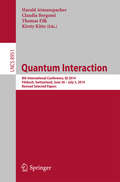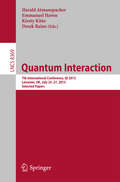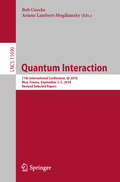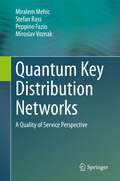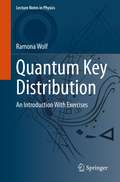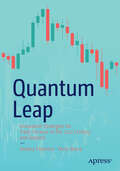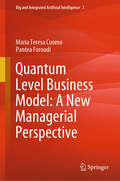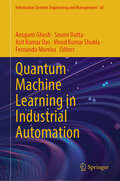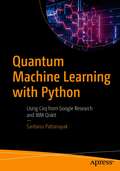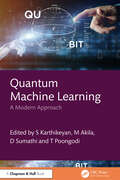- Table View
- List View
Quantum Error Correction: Symmetric, Asymmetric, Synchronizable, and Convolutional Codes (Quantum Science and Technology)
by Giuliano Gadioli La GuardiaThis text presents an algebraic approach to the construction of several important families of quantum codes derived from classical codes by applying the well-known Calderbank-Shor-Steane (CSS), Hermitian, and Steane enlargement constructions to certain classes of classical codes. In addition, the book presents families of asymmetric quantum codes with good parameters and provides a detailed description of the procedures adopted to construct families of asymmetric quantum convolutional codes.Featuring accessible language and clear explanations, the book is suitable for use in advanced undergraduate and graduate courses as well as for self-guided study and reference. It provides an expert introduction to algebraic techniques of code construction and, because all of the constructions are performed algebraically, it enables the reader to construct families of codes, rather than only codes with specific parameters. The text offers an abundance of worked examples, exercises, and open-ended problems to motivate the reader to further investigate this rich area of inquiry. End-of-chapter summaries and a glossary of key terms allow for easy review and reference.
Quantum Finance: Intelligent Forecast and Trading Systems
by Raymond S. LeeWith the exponential growth of program trading in the global financial industry, quantum finance and its underlying technologies have become one of the hottest topics in the fintech community. Numerous financial institutions and fund houses around the world require computer professionals with a basic understanding of quantum finance to develop intelligent financial systems. This book presents a selection of the author’s past 15 years’ R&D work and practical implementation of the Quantum Finance Forecast System – which integrates quantum field theory and related AI technologies to design and develop intelligent global financial forecast and quantum trading systems. The book consists of two parts: Part I discusses the basic concepts and theories of quantum finance and related AI technologies, including quantum field theory, quantum price fields, quantum price level modelling and quantum entanglement to predict major financial events. Part II then examines the current, ongoing R&D projects on the application of quantum finance technologies in intelligent real-time financial prediction and quantum trading systems. This book is both a textbook for undergraduate & masters level quantum finance, AI and fintech courses and a valuable resource for researchers and data scientists working in the field of quantum finance and intelligent financial systems. It is also of interest to professional traders/ quants & independent investors who would like to grasp the basic concepts and theory of quantum finance, and more importantly how to adopt this fascinating technology to implement intelligent financial forecast and quantum trading systems. For system implementation, the interactive quantum finance programming labs listed on the Quantum Finance Forecast Centre official site (QFFC.org) enable readers to learn how to use quantum finance technologies presented in the book.
Quantum Game Simulation (Emergence, Complexity and Computation #36)
by Ramon Alonso-SanzThis book addresses two disciplines that have traditionally occupied completely different realms: quantum information and computation, and game theory. Helping readers connect these fields, it appeals to a wide audience, including computer scientists, engineers, mathematicians, physicists, biologists or economists. The book is richly illustrated and basic concepts are accessible to readers with basic training in science. As such it is useful for undergraduate students as well as established academicians and researchers. Further, the didactic and tutorial-like style makes it ideal supplementary reading for courses on quantum information and computation, game theory, cellular automata and simulation.
Quantum Hybrid Electronics and Materials (Quantum Science and Technology)
by Hiroshi Yamaguchi Yoshiro Hirayama Kazuhiko HirakawaThis book highlights recent advances in quantum control technologies with regard to hybrid quantum systems. It addresses the following topics: phonon engineering based on phononic crystals, carbon-based nano materials like graphene and nanotubes, Terahertz light technology for single-molecule and quantum dots, nuclear-spin-based metrology for semiconductor quantum systems, quantum anomalous Hall effect in magnetic topological insulators, chiral three-dimensional photonic crystals, and bio-inspired magnonic systems. Each topic, as a component in the framework of hybrid quantum systems, is concisely presented by experts at the forefront of the field. Accordingly, the book offers a valuable asset, and will help readers find advanced technologies and materials suitable for their purposes.
Quantum Image Processing
by Fei Yan Salvador E. Venegas-AndracaThis book provides a comprehensive introduction to quantum image processing, which focuses on extending conventional image processing tasks to the quantum computing frameworks. It summarizes the available quantum image representations and their operations, reviews the possible quantum image applications and their implementation, and discusses the open questions and future development trends. It offers a valuable reference resource for graduate students and researchers interested in this emerging interdisciplinary field.
Quantum Image Processing in Practice: A Mathematical Toolbox
by Artyom M. Grigoryan Sos S. AgaianComprehensive resource addressing the need for a quantum image processing machine learning model that can outperform classical neural networks Quantum Image Processing in Practice explores the transformative potential of quantum color image processing across various domains, including biomedicine, entertainment, economics, and industry. The rapid growth of image data, especially in facial recognition and autonomous vehicles, demands more efficient processing techniques. Quantum computing promises to accelerate digital image processing (DIP) to meet this demand. This book covers the role of quantum image processing (QIP) in quantum information processing, including mathematical foundations, quantum operations, image processing using quantum filters, quantum image representation, and quantum neural networks. It aims to inspire practical applications and foster innovation in this promising field. Topics include: Qubits and Quantum Logic Gates: Introduces qubits, the fundamental data unit in quantum computing, and their manipulation using quantum logic gates like Pauli matrices, rotations, the CNOT gate, and Hadamard matrices. The concept of entanglement, where qubits become interconnected, is also explored, highlighting its importance for applications like quantum teleportation and cryptography. Two and Multiple Qubit Systems: Demonstrates the importance of using two qubits to process color images, enabling image enhancement, noise reduction, edge detection, and feature extraction. Covers the tensor product, Kronecker sum, SWAP gate, and local and controlled gates. Extends to multi-qubit superpositions, exploring local and control gates for three qubits, such as the Toffoli and Fredkin gates, and describes the measurement of superpositions using projection operators. Transforms and Quantum Image Representations: Covers the Hadamard, Fourier, and Heap transforms and their circuits in quantum computation, highlighting their applications in signal and image processing. Introduces the quantum signal-induced heap transform for image enhancement, classification, compression, and filtration. Explores quantum representations and operations for images using the RGB, XYZ, CMY, HSI, and HSV color models, providing numerous examples. Fourier Transform Qubit Representation: Introduces a new model of quantum image representation, the Fourier transform qubit representation. Describes the algorithm and circuit for calculating the 2-D quantum Fourier transform, enabling advancements in quantum imaging techniques. New Operations and Hypercomplex Algebra: Presents new operations on qubits and quantum representations, including multiplication, division, and inverse operations. Explores hypercomplex algebra, specifically quaternion algebra, for its potential in color image processing. Quantum Neural Networks (QNNs): Discusses QNNs and their circuit implementation as advancements in machine learning driven by quantum mechanics. Summarizes various applications of QNNs and current trends and future developments in this rapidly evolving field. The book also addresses challenges and opportunities in QIP research, aiming to inspire practical applications and innovation. It is a valuable resource for researchers, students, and professionals interested in the intersection of quantum computing and color image processing applications, as well as those in visual communications, multimedia systems, computer vision, entertainment, and biomedical applications.
Quantum Information Meets Quantum Matter: From Quantum Entanglement to Topological Phases of Many-Body Systems (Quantum Science and Technology)
by Bei Zeng Xie Chen Duan-Lu Zhou Xiao-Gang WenThis book approaches condensed matter physics from the perspective of quantum information science, focusing on systems with strong interaction and unconventional order for which the usual condensed matter methods like the Landau paradigm or the free fermion framework break down. Concepts and tools in quantum information science such as entanglement, quantum circuits, and the tensor network representation prove to be highly useful in studying such systems. The goal of this book is to introduce these techniques and show how they lead to a new systematic way of characterizing and classifying quantum phases in condensed matter systems. The first part of the book introduces some basic concepts in quantum information theory which are then used to study the central topic explained in Part II: local Hamiltonians and their ground states. Part III focuses on one of the major new phenomena in strongly interacting systems, the topological order, and shows how it can essentially be defined and characterized in terms of entanglement. Part IV shows that the key entanglement structure of topological states can be captured using the tensor network representation, which provides a powerful tool in the classification of quantum phases. Finally, Part V discusses the exciting prospect at the intersection of quantum information and condensed matter physics – the unification of information and matter. Intended for graduate students and researchers in condensed matter physics, quantum information science and related fields, the book is self-contained and no prior knowledge of these topics is assumed.
Quantum Information Processing with Finite Resources
by Marco TomamichelThis book provides the reader with the mathematical framework required to fully explore the potential of small quantum information processing devices. As decoherence will continue to limit their size, it is essential to master the conceptual tools which make such investigations possible. A strong emphasis is given to information measures that are essential for the study of devices of finite size, including Rényi entropies and smooth entropies. The presentation is self-contained and includes rigorous and concise proofs of the most important properties of these measures. The first chapters will introduce the formalism of quantum mechanics, with particular emphasis on norms and metrics for quantum states. This is necessary to explore quantum generalizations of Rényi divergence and conditional entropy, information measures that lie at the core of information theory. The smooth entropy framework is discussed next and provides a natural means to lift many arguments from information theory to the quantum setting. Finally selected applications of the theory to statistics and cryptography are discussed. The book is aimed at graduate students in Physics and Information Theory. Mathematical fluency is necessary, but no prior knowledge of quantum theory is required.
Quantum Information Processing: Theory and Implementation (Graduate Texts in Physics)
by Mark Hillery János A. Bergou Mark SaffmanThis new edition of a well-received textbook provides a concise introduction to both the theoretical and experimental aspects of quantum information at the graduate level. While the previous edition focused on theory, the book now incorporates discussions of experimental platforms. Several chapters on experimental implementations of quantum information protocols have been added: implementations using neutral atoms, trapped ions, optics, and solidstate systems are each presented in its own chapter. Previous chapters on entanglement, quantum measurements, quantum dynamics, quantum cryptography, and quantum algorithms have been thoroughly updated, and new additions include chapters on the stabilizer formalism and the Gottesman-Knill theorem as well as aspects of classical and quantum information theory. To facilitate learning, each chapter starts with a clear motivation to the topic and closes with exercises and a recommended reading list. Quantum Information Processing: Theory and Implementation will be essential to graduate students studying quantum information as well as and researchers in other areas of physics who wish to gain knowledge in the field.
Quantum Information and Coherence
by Erika Andersson Patrik ÖhbergThis book offers an introduction to ten key topics in quantum information science and quantum coherent phenomena, aimed at graduate-student level. The chapters cover some of the most recent developments in this dynamic research field where theoretical and experimental physics, combined with computer science, provide a fascinating arena for groundbreaking new concepts in information processing. The book addresses both the theoretical and experimental aspects of the subject, and clearly demonstrates how progress in experimental techniques has stimulated a great deal of theoretical effort and vice versa. Experiments are shifting from simply preparing and measuring quantum states to controlling and manipulating them, and the book outlines how the first real applications, notably quantum key distribution for secure communication, are starting to emerge. The chapters cover quantum retrodiction, ultracold quantum gases in optical lattices, optomechanics, quantum algorithms, quantum key distribution, quantum control based on measurement, orbital angular momentum of light, entanglement theory, trapped ions and quantum metrology, and open quantum systems subject to decoherence. The contributing authors have been chosen not just on the basis of their scientific expertise, but also because of their ability to offer pedagogical and well-written contributions which will be of interest to students and established researchers.
Quantum Information in the Nanoelectronic World (Synthesis Lectures on Engineering, Science, and Technology)
by David K. FerryThis book provides a concise introduction to quantum information and quantum science. The author discusses in language accessible to a broad audience, the why and how, as well as implementation technologies. The discussion includes coverage of general computing (e.g., Turing ideas) for comparison, and ideas like entropy and minimum dissipation. Topics such as quantum communications and quantum sensing enhance the discussion of quantum computing. In addition, the manner in which entanglement is used in each of these sub-fields is addressed with applications and, for example, a discussion of the quantum Fourier transform.
Quantum Information, Computation and Cryptography
by Fabio Benatti Dimitri Petritis Mark Fannes Roberto FloreaniniThis multi-authored textbook addresses graduate students with a background in physics, mathematics or computer science. No research experience is necessary. Consequently, rather than comprehensively reviewing the vast body of knowledge and literature gathered in the past twenty years, this book concentrates on a number of carefully selected aspects of quantum information theory and technology. Given the highly interdisciplinary nature of the subject, the multi-authored approach brings together different points of view from various renowned experts, providing a coherent picture of the subject matter. The book consists of ten chapters and includes examples, problems, and exercises. The first five present the mathematical tools required for a full comprehension of various aspects of quantum mechanics, classical information, and coding theory. Chapter 6 deals with the manipulation and transmission of information in the quantum realm. Chapters 7 and 8 discuss experimental implementations of quantum information ideas using photons and atoms. Finally, chapters 9 and 10 address ground-breaking applications in cryptography and computation.
Quantum Interaction
by Emmanuel Pothos Bob Coecke Jose Acacio de BarrosThis book constitutes the thoroughly refereed post-conference proceedings of the 10th International Conference on Quantum Interaction, QI 2016, held in San Francisco, CA, USA, in July 2016. The 21 papers presented in this book were carefully reviewed and selected from 39 submissions. The papers address topics such as: Fundamentals; Quantum Cognition; Language and Applications; Contextuality and Foundations of Probability; and Quantum-Like Measurements.
Quantum Interaction
by Harald Atmanspacher Thomas Filk Claudia Bergomi Kirsty KittoThis book constitutes the refereed proceedings of the 8th International Conference on Quantum Interaction, QI 2014, held in Filzbach, Switzerland, in June/July 2014. The 19 papers together with 20 invited keynotes presented in this book were carefully selected from 22 submissions. Quantum Interaction has developed into an emerging interdisciplinary area of science combining research topics in fundamental issues, semantic and memory, decision making, games, politics and social aspects, non-locality and entanglement.
Quantum Interaction
by Emmanuel Haven Harald Atmanspacher Kirsty Kitto Derek RaineThis book constitutes the refereed proceedings of the 7th International Conference on Quantum Interaction, QI 2013, held in Leicester, UK, in July 2013. The 31 papers presented in this book were carefully selected from numerous submissions. The papers cover various topics on quantum interaction and revolve around four themes: information processing/retrieval/semantic representation and logic; cognition and decision making; finance/economics and social structures and biological systems.
Quantum Interaction: 11th International Conference, QI 2018, Nice, France, September 3–5, 2018, Revised Selected Papers (Lecture Notes in Computer Science #11690)
by Bob Coecke Ariane Lambert-MogilianskyThis book constitutes the thoroughly refereed post-conference proceedings of the 10th International Conference on Quantum Interaction, QI 2018, held in Nice, France, in September 2018.The 12 papers presented in this book were carefully reviewed and selected from 15 submissions. The papers address topics such as: psychology, economics, semantic and memory, natural language processing, cognition, information retrieval, biology, and political science.
Quantum Interaction: 7th International Conference, QI 2013, Leicester, UK, July 25-27, 2013. Selected Papers (Lecture Notes in Computer Science #8369)
by Harald Atmanspacher, Emmanuel Haven, Kirsty Kitto and Derek RaineThis book constitutes the refereed proceedings of the 7th International Conference on Quantum Interaction, QI 2013, held in Leicester, UK, in July 2013. The 31 papers presented in this book were carefully selected from numerous submissions. The papers cover various topics on quantum interaction and revolve around four themes: information processing/retrieval/semantic representation and logic; cognition and decision making; finance/economics and social structures and biological systems.
Quantum Key Distribution Networks: A Quality of Service Perspective
by Stefan Rass Miralem Mehic Peppino Fazio Miroslav VoznakThis book focuses on practical implementation details, telecommunication techniques, security and technology challenges and approaches to implementing quantum technology in modern telecommunication systems. The authors use their extensive practical academic and industrial experience in network technologies and provide details from international projects in quantum cryptography in which they actively participate. Using a variety of examples, analogies, illustrations, tables, and features from practical quantum network realizations, the authors provide a unique view of quantum technology from an engineering telecommunication standpoint, allowing the reader to identify the advantages and challenges of quantum technology.This book also addresses challenges posed by quantum technology such as network organization, passive and active eavesdropping, and future trends in QKD such as Software Defined Networking (SDN) with QKD and application QKD in 5G networks. It is conceived through eight chapters by treating the following thematic units separately: Fundamentals of Quantum Key Distribution, QoS architecture/mode, QoS MAC layer, QoS signaling techniques for key management and session negotiation purpose and QoS routing protocols that minimize the consumption of key material through the equitable utilization of network resources when finding an optimal path. Through numerous information on practical solutions, simulation examples, illustrations, and analysis, readers can easily distinguish the specificity of quantum technology and understand the challenges and methods of practical implementation of quantum cryptography in common telecommunications standards. Researchers working in quantum technology and applied networking security as well as advanced-level students studying computer science and electrical engineering will benefit from this book. Professionals working within these related fields will also benefit from this book.
Quantum Key Distribution: An Introduction with Exercises (Lecture Notes in Physics #988)
by Ramona WolfThis textbook introduces the non-specialist reader to the concepts of quantum key distribution and presents an overview of state-of-the-art quantum communication protocols and applications. The field of quantum cryptography has advanced rapidly in the previous years, not least because with the age of quantum computing drawing closer, traditional encryption methods are at risk.The textbook presents the necessary mathematical tools without assuming much background, making it accessible to readers without experience in quantum information theory. In particular, the topic of classical and quantum entropies is presented in great detail. Furthermore, the author discusses the different types of quantum key distribution protocols and explains several tools for proving the security of these protocols. In addition, a number of applications of quantum key distribution are discussed, demonstrating its value to state-of-the-art cryptography and communication. This book leads the reader through the mathematical background with a variety of worked-out examples and exercises. It is primarily targeted at graduate students and advanced undergraduates in theoretical physics. The presented material is largely self-contained and only basic knowledge in quantum mechanics and linear algebra is required.
Quantum Leap: Innovative Strategies for Trade Finance in the 21st Century and Beyond
by Andrea Frosinini Venu BorraDevelop a comprehensive understanding of the evolving landscape of digital trade and finance, including the historical context and the transformative impact of technological innovations on traditional practices. This book charts the relentless march of digitalization within these sectors, highlighting how technological innovations have transformed traditional practices that have stood the test of time. After a detailed historical overview, the narrative then delves into an array of recent experiments within the digital trade and finance realms, some of which have unfortunately faltered, offering valuable lessons on the challenges and pitfalls of implementing new technologies. These case studies serve not only as cautionary tales but also as springboards for innovation, illustrating the critical need for adaptability and careful strategic planning in the face of digital evolution. A significant focus of the book is on the concept of Regenerative Finance (ReFi) applied to international trade and trade finance. This emerging paradigm, aimed at restoring and revitalizing ecosystems and communities through financial practices, is presented as a revolutionary goal for the future of trade. By leveraging the power of digital tools and smart markets, ReFi promises to drive sustainability and resilience within global trade systems, aligning economic activities with ecological and social well-being. The book culminates in an exploration of the rise of smart markets—highly efficient, transparent, and participatory trading ecosystems enabled by cutting-edge technologies like blockchain, artificial intelligence, and the Internet of Things (IoT). These digital platforms are redefining the parameters of trade and finance, making transactions faster, safer, and more inclusive. Quantum Leap provides a thorough understanding of the current state of digital trade and finance and offers a visionary outlook on how these sectors can evolve towards more sustainable and regenerative practices. What You Will Learn Gain a global perspective on digital trade and finance, understanding the implications for diverse stakeholders including industry professionals, policymakers, and academics, and recognizing the interconnectedness of global trade systems. Evaluate the role of digital trade and finance in driving sustainability and social impact, exploring ways in which these sectors can contribute to ecological and social well-being, and promoting equitable and sustainable practices. Reflect on ethical considerations in digital trade and finance, including issues of privacy, security, and equity, and cultivate responsible leadership skills for promoting ethical practices and driving positive change in the industry. Explore innovative approaches to trade and finance, and envision the future trajectory of these sectors, recognizing the potential for transformative change driven by digital technologies. Who This Book Is For Written for a diverse audience, from newbies to industry and IT professionals
Quantum Level Business Model: A New Managerial Perspective (Big and Integrated Artificial Intelligence #3)
by Pantea Foroudi Maria Teresa CuomoEmbracing complexity as an opportunity, this groundbreaking book introduces Quantum Level Management—an agile, probabilistic, and interconnected approach to business. By applying principles from Quantum Science, it offers a radically new framework for strategic planning, decision-making, and organizational design. A key contribution is its ambidextrous logic: the ability to balance structure with flexibility, control with creativity, and stability with innovation. A dedicated section explores real-world applications in financial markets, a critical arena for testing and advancing Quantum Technologies. With critical insights, practical tools, and compelling case studies, this book empowers students, scholars, executives, and entrepreneurs to navigate an uncertain and dynamic quantum environment.
Quantum Machine Learning and Optimisation in Finance: On the Road to Quantum Advantage
by Antoine Jacquier Alexander Lipton Oleksiy Kondratyev Marcos Lopez PradoLearn the principles of quantum machine learning and how to apply them in finance.Purchase of the print or Kindle book includes a free eBook in the PDF format.Key FeaturesDiscover how to solve optimisation problems on quantum computers that can provide a speedup edge over classical methodsUse methods of analogue and digital quantum computing to build powerful generative modelsCreate the latest algorithms that work on Noisy Intermediate-Scale Quantum (NISQ) computersBook DescriptionWith recent advances in quantum computing technology, we finally reached the era of Noisy Intermediate-Scale Quantum (NISQ) computing. NISQ-era quantum computers are powerful enough to test quantum computing algorithms and solve hard real-world problems faster than classical hardware.Speedup is so important in financial applications, ranging from analysing huge amounts of customer data to high frequency trading. This is where quantum computing can give you the edge. Quantum Machine Learning and Optimisation in Finance shows you how to create hybrid quantum-classical machine learning and optimisation models that can harness the power of NISQ hardware.This book will take you through the real-world productive applications of quantum computing. The book explores the main quantum computing algorithms implementable on existing NISQ devices and highlights a range of financial applications that can benefit from this new quantum computing paradigm.This book will help you be one of the first in the finance industry to use quantum machine learning models to solve classically hard real-world problems. We may have moved past the point of quantum computing supremacy, but our quest for establishing quantum computing advantage has just begun!What you will learnTrain parameterised quantum circuits as generative models that excel on NISQ hardwareSolve hard optimisation problemsApply quantum boosting to financial applicationsLearn how the variational quantum eigensolver and the quantum approximate optimisation algorithms workAnalyse the latest algorithms from quantum kernels to quantum semidefinite programmingApply quantum neural networks to credit approvalsWho this book is forThis book is for Quants and developers, data scientists, researchers, and students in quantitative finance. Although the focus is on financial use cases, all the methods and techniques are transferable to other areas.
Quantum Machine Learning in Industrial Automation (Information Systems Engineering and Management #65)
by Asit Kumar Das Soumi Dutta Fernando Moreira Anupam Ghosh Vinod Kumar ShuklaThis book focuses on quantum machine learning that harnesses the collective properties of quantum states, such as superposition, interference, and entanglement, uses algorithms run on quantum devices, such as quantum computers, to supplement, expedite, or support the work performed by a classical machine learning program. The devices that perform quantum computations are known as quantum computers. Quantum computers have the potential to revolutionize computation by making certain types of classically intractable problems solvable. A few large companies and small start-ups now have functioning non-error-corrected quantum computers composed of several tens of qubits, and some of these are even accessible to the public through the cloud. Additionally, quantum simulators are making strides in fields varying from molecular energetics to many-body physics. Most known use cases fit into four archetypes: quantum simulation, quantum linear algebra for AI and machine learning, quantum optimization and search, and quantum factorization. Advantages of quantum computing are many and to list a few, first, they&’re fast. Ultimately, quantum computers have the potential to provide computational power on a scale that traditional computers cannot ever match. In 2019, for example, Google claimed to carry out a calculation in about 200 seconds that would take a classical supercomputer around 10,000 years. Second, they can solve complex problems. The more complex a problem, the harder it is for even a supercomputer to solve. When a classical computer fails, it&’s usually because of a huge degree of complexity and many interacting variables. However, due to the concepts of superposition and entanglement, quantum computers can account for all these variables and complexities to reach a solution. Last but not the least, they can run complex simulations. The speed and complexity that quantum computing can achieve means that, in theory, a quantum computer could simulate many intricate systems.
Quantum Machine Learning with Python: Using Cirq from Google Research and IBM Qiskit
by Santanu PattanayakQuickly scale up to Quantum computing and Quantum machine learning foundations and related mathematics and expose them to different use cases that can be solved through Quantum based algorithms.This book explains Quantum Computing, which leverages the Quantum mechanical properties sub-atomic particles. It also examines Quantum machine learning, which can help solve some of the most challenging problems in forecasting, financial modeling, genomics, cybersecurity, supply chain logistics, cryptography among others.You'll start by reviewing the fundamental concepts of Quantum Computing, such as Dirac Notations, Qubits, and Bell state, followed by postulates and mathematical foundations of Quantum Computing. Once the foundation base is set, you'll delve deep into Quantum based algorithms including Quantum Fourier transform, phase estimation, and HHL (Harrow-Hassidim-Lloyd) among others. You'll then be introduced to Quantum machine learning and Quantum deep learning-based algorithms, along with advanced topics of Quantum adiabatic processes and Quantum based optimization. Throughout the book, there are Python implementations of different Quantum machine learning and Quantum computing algorithms using the Qiskit toolkit from IBM and Cirq from Google Research.What You'll LearnUnderstand Quantum computing and Quantum machine learningExplore varied domains and the scenarios where Quantum machine learning solutions can be appliedDevelop expertise in algorithm development in varied Quantum computing frameworksReview the major challenges of building large scale Quantum computers and applying its various techniquesWho This Book Is ForMachine Learning enthusiasts and engineers who want to quickly scale up to Quantum Machine Learning
Quantum Machine Learning: A Modern Approach
by T. Poongodi D. Sumathi S. Karthikeyan M. AkilaThis book presents the research into and application of machine learning in quantum computation, known as quantum machine learning (QML). It presents a comparison of quantum machine learning, classical machine learning, and traditional programming, along with the usage of quantum computing, toward improving traditional machine learning algorithms through case studies.In summary, the book: Covers the core and fundamental aspects of statistics, quantum learning, and quantum machines. Discusses the basics of machine learning, regression, supervised and unsupervised machine learning algorithms, and artificial neural networks. Elaborates upon quantum machine learning models, quantum machine learning approaches and quantum classification, and boosting. Introduces quantum evaluation models, deep quantum learning, ensembles, and QBoost. Presents case studies to demonstrate the efficiency of quantum mechanics in industrial aspects. This reference text is primarily written for scholars and researchers working in the fields of computer science and engineering, information technology, electrical engineering, and electronics and communication engineering.
